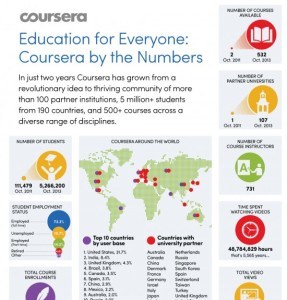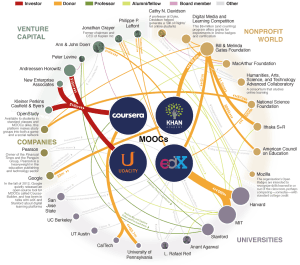Coursera: using network effects to build access to education

Coursera is leveraging network effects to expand both its user base as well as the quantity and quality of content on its platform.
Coursera is a for-profit, education technology company providing massive open online courses (MOOCs). Currently, Coursera has 15.3M users (or “learners”), 1,371 courses, and 128 content partners (generally universities).
Value creation
For learners, Coursera provides exposure and access to high quality academic content that might otherwise be unavailable if learners are in low income countries or if they come from low socio-economic backgrounds. Beyond providing access, Coursera allows learners to develop critical skills that make them more employable. A recent survey of over 50,000 individuals who have completed a Coursera course found that 85% experienced an intangible boost (e.g. enhanced skills) while 33% gained tangible benefits (e.g. got a new job, started a business, received a pay increase or promotion). Lastly, Coursera promotes and enables “lifelong learning,” going against the notion that education should end after college or even graduate school.
For content partners, Coursera allows brand building for institutions and individual professors. It allows universities to explore MOOCs and related technological developments that enable a blended learning model that combines online and offline components in the classroom. Coursera also provides content partners with valuable data about learners and engagement.

Value capture
- Learners can pay for verified certificates (“Signature Track”) upon course completion to prove to employers that they have successfully passed a university-level course; these can range from $30-$100/course. Coursera reported $1M in revenue from Signature Track in 2013.
- Coursera has also partnered with corporations and received revenue for employee training via the Coursera platform, as well as through corporate sponsorships of course development.
Network effects
The learner side of the Coursera platform exhibits direct network effects. Through taking Coursera courses, learners are expected to evaluate and provide feedback on each other’s work. The more users there are, the more perspectives a single learner is likely to get on his/her work. In addition, Coursera has set up web forums for courses that allow students to interact and have a virtual classroom with other learners around the world. Some students even arrange face to face study “meet-ups” with other learners, which increases affinity for the platform as well as learner engagement.
At the same time, there are indirect network effects at play between the learners and the content partners. Creating a course on the platform actually involves a large investment from content partners because Coursera does not help with content production or cover any associated costs. Therefore, content partners require a large and engaged learner base to encourage content production. A large user base ensures a revenue stream for content partners (they get a revenue and profit share from Coursera verified certificates), as well as a high level of brand exposure. In addition, higher quantity and quality of courses will attract new learners to the platform, and keep existing learners coming back for more.
Going forward, Coursera may continue to move into corporate collaborations, which could become another key player on the platform exhibiting indirect network effects. In addition to the employee training and corporate sponsorships described above, Coursera has also developed “specializations” that involve a series of courses culminating in a capstone project for a corporation.
Scaling a business with network effects
Coursera did a good job in recognizing the network effects inherent in its business, and scaling accordingly to become one of the largest MOOC players in the market today. In its earliest days, Coursera offered all courses for free. After verified certificates were rolled out, learners could opt to pay for the certificate at the end of the course, or take the exact same course for free (just without the certificate). In this way, Coursera grew its user base very quickly.
In terms of partnerships with content providers, Coursera started with a handful of very forward thinking, prestigious universities (e.g. UPenn). Once other universities saw the traction the platform was gaining, along with the credible universities that were already on it, they jumped on the bandwagon as well.
Overall, this growth has been sustainable because learners cannot easily bypass the platform and access content directly from the source (e.g. barriers to entry are high to get into universities). In addition, Coursera has maintained its “logic of conversion” of tangible learner results and positive press for content partners that continue to drive both sides of the platform. Going forward, I think the challenge will be combating multihoming tendencies of both learners and content partners across multiple platforms (e.g. Udacity, edX, Khan Academy, etc.).
Selected sources
https://www.edsurge.com/news/2014-10-15-how-does-coursera-make-money





I completely agree that Coursera and the other MOOCs try to build in direct network effects by encouraging discussions and peer work. I wonder, though, if there are actually two kinds of users, the “casual” learners and the “serious” learners, and whether a MOOC actually wants to encourage the growth of both groups.
My experience with MOOC courses has generally been that the student discussions are a bit chaotic and all over the place in terms of background knowledge and understanding of the course materials. This might be caused by or compounded by the fact that the standards for “passing” a course are relatively low (a bit higher for certification, but certificate-track students and non-track students are generally grouped together for discussion and work, I believe), which leads to more “casual” learners. While I think discriminating against these kinds of students would go against the core principles of a MOOC, I do think their presence somewhat detracts from the experience of the “serious” learners, who have a harder time getting high-quality and equally-interest-matched feedback from other “serious” learner peers.
In essence, I think the direct network effects highlighted in your post actually hurt MOOCs, and I wonder if there’s a way or a precedent for a product to foster self-selection and network effects within just a subset of its user base. I don’t know if players like Coursera or EdX would do this anytime soon – they are currently focused on growth in users and revenue, not necessarily providing the best “serious” learner environment.
Companies like Coursera play a crucial role in transforming the education paradigm in the U.S. and the world. There’s a great TED talk by Sir Ken Robinson (http://www.ted.com/talks/ken_robinson_says_schools_kill_creativity) about how our school systems fail children by forcing them into a very specific box that serves a small minority of the student population. By providing access to thousands of courses, students can choose what they want to learn and go at their own pace, rather than being force-fed by public and private educational institutions.
If companies like Coursera can continue to democratize education via network effects, many will call into question who our school system is really serving (both public and private). It certainly isn’t the students. I could see Coursera playing a huge role in bringing homeschooling into the mainstream and preparing students to enter the world by discovering their true passions and talents, rather than forcing them to learn from books chosen by state and federal authorities.
Interesting post! I truly like Coursera’s direct network effect. In some way it reminds me of the HBS Digit blog posting & commenting. I believe if you find appropriate incentives for students to structure their conversations / provide only good quality comments, you can significantly boost individual learning experience beyond one’s horizon and with limited time / cost investment from the provider.